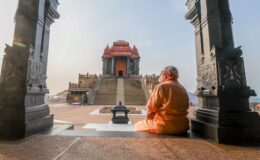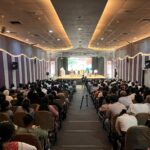Civilisational glory
- By : Anirban Ganguly
- Category : Articles

With the aim of civilisational harmony, Prime Minister Modi has been adept at crafting a stable foreign policy for India.
That India’s foreign outreach has become resilient, imaginative, pragmatic and bold in the last four years is an undeniable fact. Prime Minister Modi’s visit to Israel, the first by an Indian Prime Minister in seven decades, along with Prime Minister Benjamin Netanyahu’s first visit to India, its wide ramification and the intense discussions that it generated is a clear example of how India’s external outreach has assumed coherence and direction and is determined to pursue India’s strategic as well as civilisational interest.
For those, who sometime back felt or argued that there was no “Modi Doctrine” in India’s foreign policy, one can only say that a Modi Doctrine in foreign policy is not a linear construct, nor is it a predictable theory or experiment, nor can it be articulated as a settled reaction, narrative or series of action. It is pragmatic, realistic, ever-evolving and transmuting while being driven by a deep and undiluted idealism and a clear sense of India’s place and position in the new global order. In its expressions, if a few steps backwards are at times spotted or discerned, it does not mean a battre on retraite, it reflects rather the pursuance of a tactical line, a reasoned back stepping meant for leaping further and more surely, without the risk of falling in between two summits.
At the same time, while propounding and pursuing a definitive civilisational agenda for India, India’s foreign policy has, in a sense, displayed grassroots sensitivity and responsiveness. While a certain bunch of elite analysts laugh and sneer at external affairs minister Sushma Swaraj’s hourly and daily proactiveness on social media as a response to the appeals of ordinary Indians facing difficult situations and tribulations abroad, it only shows that Indian foreign policy under the Narendra Modi dispensation operates at the broad horizon level while also being active and effective at the micro-dimension.
A sense of Indianness, a sense of being of and for India, a consciousness of citizenship is what exercises such activism that sees the foreign minister herself responding to exigencies, giving direction towards finding ways out of difficult cul de sac situations. Such an activism certainly comes from a firm sense of India’s place and aspirations in the world; it is only a laissez-faire and shirking consciousness that evolves a hands-off policy when it comes to one’s citizens, who are either stranded or facing challenging situations abroad.
One of the first things that a nation and civilisation does, while trying to evolve a great power narrative, a civilisational matrix, is to actively standby, protect and promote its legitimate interests and constituents, which may be strategic, physical and emotional-cultural.
India’s Foreign policy, in the last four years, has certainly broken the elite, intelligentsia and smart analysts preserve, it has generated wide discussion among people and has exhibited a rare responsiveness not seen in seven decades.
The Republic Day celebrations this year shall witness an unprecedented congregation with the presence and participation of all the leaders of the ASEAN countries. Continuous and sustained efforts of the last three years have brought to fruition this congregation with great symbolic import. India’s relation and engagement with ASEAN are unique, in that it is the resumption of a deeply civilisational bond of mutuality and of exchange.
ASEAN’s uniqueness has been that it has survived and grown from strength to strength by deftly balancing its own diversity, its political compulsions and the region’s fast-changing dynamics. It has not subsumed itself to regional hegemony; it has not allowed itself to enter into a subsidiary relationship with the largest power in its neighbourhood. Its success has been phenomenal if one were to keep in mind the political evolution of the region in the last three decades.
As the Singaporean diplomat and public intellectual Kishore Mahbubani and his co-author the former diplomat and academic Jeffery Sng, in their latest study, “The ASEAN Miracle: a catalyst for peace” have noted, “ASEAN is a living and breathing modern miracle. Why? No other regional organisation has done as much as” ASEAN, “to improve the living conditions of a broad swath of humanity.
The more than 600 million people living in the region have seen remarkable progress in the 50 years since the formation of the association. ASEAN has brought peace and prosperity to a troubled region, generated inter-civilisational harmony in the most diverse corner of the earth and brought hope to many people…”
That which binds India uniquely to the ASEAN collective is her cultural-civilisational ties. A bond that has been, over the centuries, welcomed, celebrated, innovated, grafted upon and often transmuted to appear with a distinct regional identity of its own. While, as the authors of the ‘ASEAN Miracle” note, “Economic relationship is important”, India also “needs to strengthen the cultural relationship. No other partner, not the US, not Europe and not even China, can match India’s long historical association with Southeast Asia…India can expect a warm welcome if it launches a major push to build new cultural bridges with Southeast Asia.”
On the geopolitical front, India, they argue, can provide a political buffer for ASEAN. India has consistently proven, especially in the last three years or so, that she is a responsible power, a stable power, a power that is willing to work for her own interests, for the region’s stability and prosperity with a certain confidence which comes with the realisation of a civilisational role. “If India were to strengthen its political presence and play a stronger role in Southeast Asia in the coming decades, it would receive a positive response from ASEAN countries,” argue Mahbubani and Sng.
The India-ASEAN Republic Day gathering opens up greater possibilities and opportunities towards further exploring and achieving those aspirations…

















